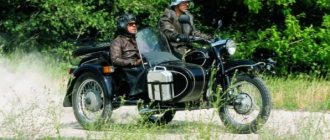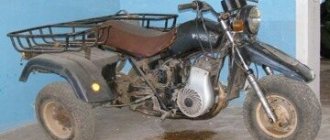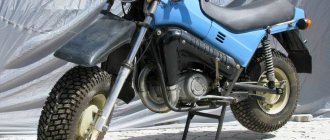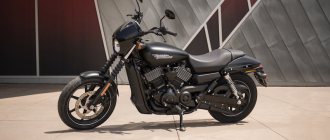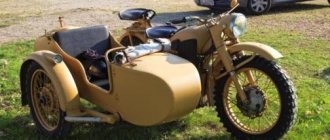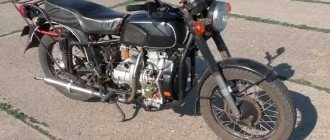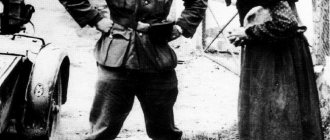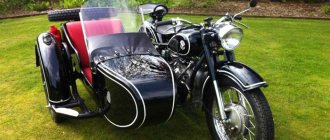RU-MOTO rating
- Reliability
- Chassis
- Appearance
- Comfort
4.5
Verdict
Looking at such motorcycles, you understand the approach with which the equipment was created. The dominant factor was the creation of a durable, workhorse, and such concepts as comfort, appearance and dynamics faded into the background. Now such an idea will not find its consumer. Therefore, the Dnieper has already become an interesting page in our history.
The Dnepr motorcycle is a child of the Kyiv motorcycle plant. Given its characteristics, there is no need to talk about a bright plastic fairing, acceleration to a hundred or noisy shots along the avenue. This is not about him, but he doesn’t need it, his path is different - he is a real hard worker.
Motorcycles of this brand appeared immediately after the war, and went through a thorny path in such difficult years for the industry. Now we are accustomed to perceiving a motorcycle as a luxury item, but back then, with a shortage of automobiles, it was an irreplaceable thing. The Dnepr could be used not just as a motorcycle with a sidecar for the family, but as a tractor and a truck, carrying the difficult life of a Soviet person on its shoulders.
Dnepr M-72 prototype - German BMW R-71
It is also interesting that the first-born in the line - the M-72 motorcycle - became the Soviet incarnation of the German representative BMW R-71.
The lineup then looked like this:
- 1952 - model M72;
Dnepr M-72
- 1958 - model K750;
Motorcycle Dnepr K-750
- 1963 - model K750M;
Motorcycle Dnepr K-750M
Read other motorcycle reviews of HONDA CBR1100XX – a fast motorcycle for brave people
- 1968 - model K650 “Dnepr” (MT-8);
Motorcycle Dnepr K-650
- 1971 - model MT-9;
Motorcycle Dnepr MT-9
- 1974 - model MT-10;
Motorcycle Dnepr MT-10
- 1976 - model MT-10-36;
- 1978 - model MT-12;
Motorcycle Dnepr MT-12
- 1985 - model MT-11;
Motorcycle Dnepr MT-11
- 1986 - model MT-16;
Motorcycle Dnepr MT-16
- 1991 - model Dnepr KMZ 8.157.01 “Solo”;
Motorcycle Dnepr KMZ 8.157.01 “Solo”
Read other motorcycle reviews Review of the Minsk D4 125 motorcycle
- 1991 - model Dnepr KMZ 8.157.02.
Motorcycle Dnepr KMZ 8.157.02
There were other models, but they were less common and highly specialized. And as an example for study, we decided to take the MT-10-36 model.
Design
Early modifications outwardly look like twin brothers of German motorcycles - not surprising, since they were copied from them. Subsequently, the appearance changed several times, but only slightly, and an inexperienced biker is unlikely to distinguish the Dnieper from the Urals at first glance. In that era, no one thought about design, and technical characteristics were put at the forefront, not appearance.
Was there quality?
We are already examining our copy. Opening the valve covers showed that the motorcycle had indeed hardly been driven - as if it had left the factory yesterday. But all chrome coatings already have a touch of rust. The fork legs are not polished at all, the chrome on the mufflers has already turned yellow, the steering wheel is all pockmarked. The paint on the frame is falling off in places, and the bottom of the cradle is completely rusty, and the painted rims have also “bloomed.”
If you look closely, no one particularly prepared the steel surfaces before painting. Weld beads, creepy welds and stamping defects are visible everywhere. The signature markings (silver stripes) are applied haphazardly, and the painting itself differs from detail to detail. Frankly, you won’t find such quality of painting now even on the lowest quality Chinese motorcycles.
Dnepr-16 also amazes with its careless approach to the electrical system. The wires are routed in uninsulated sleeves, the plug connectors (SHR) are without waterproofing at all, and the fuse box is in no way protected from rain. We see a similar approach with a few relays - they are not sealed at all.
The engine, gearbox and rear axle are all covered in oil leaks. Of course, you can attribute such leaks to the motorcycle being idle for a long time. We tighten all the bolts and thoroughly wipe all the units dry. Still, over time, oil leaks everywhere. Even the shock absorbers “sweat.” We check the levels, top up if necessary, and prepare for the test ride.
But our Dnepr-16 started up from the first “kick”. The engine runs stably. It's time to go.
Specifications
For its time, the Dnepr motorcycle was very good, and it was not without reason that it was compared with the products of the Irbit Motor Plant. About 50-60 years ago it was much more prestigious to have a KMZ, and not some Harley-Davidson WLA left over from Lend-Lease deliveries. But now, alas, Soviet motorcycles can no longer withstand any competition with modern analogues.
Engine
Over the years, Kiev designers experimented with different air-cooled boxer engines - 650 cubic meters and 750 cubic meters, lower valve and overhead valve. In the most common modifications of the Dnepr, the engine power reaches 32 hp , and the maximum speed of the motorcycle exceeds 100 km/h . It is also worth remembering that this engine is extremely sensitive to oil starvation, which can very quickly damage it. The engine life, according to some sources, is about 20-25 thousand kilometers in early versions (produced in the 50s and 60s) and more than 40 thousand kilometers in more recent ones.
Transmission
The classic 4-speed gearbox with reverse shifts surprisingly smoothly. Its quality is excellent, and problems rarely arise with it, thanks to which some Ural owners even change their gearbox to one borrowed from a Kyiv bike. The transmission, of course, is as simple as a brick, but that is why it is so reliable.
Chassis and brakes
On early versions, simple spring shock absorbers , which were later replaced with hydraulic ones. The suspension can be called, without exaggeration, good, especially starting with the MT10 model. Tough and resilient , it can easily withstand the weight of a heavy motorcycle, passengers and cargo, even on rough terrain. But the brakes leave much to be desired, but it would be naive to expect anything different from drum brake mechanisms of an ancient design.
Electronics
The first modifications were produced with a 6-volt on-board network, but in 1974 it was replaced with a 12-volt one. This did not entail any complications in the design, and all the electronic content of the Dnepr can easily fit into a small package from some Pyaterochka. True, due to age, the wires often rot, so it makes sense to check them carefully after purchase, replacing them with new ones if necessary.
Weight and dimensions
On average, the weight of a motorcycle together with a side trailer is about 320-350 kg, and without it - about 210 kg . Quite modest figures, considering that Soviet engineers did not even try to lighten the design, using steel, cast iron and other heavy alloys as materials. The wheelbase can be called medium in length, it is about 150 cm, plus or minus depending on the specific version.
Controllability
With a sidecar, the bike's maneuverability leaves much to be desired, given its size and weight. Without a side trailer, the situation improves, but not much, and it clearly lacks agility. But the small turning radius, coupled with tolerable suspensions on the latest modifications, make it quite suitable for driving.
Fuel consumption
With original carburetors, especially untuned ones , gasoline consumption can reach terrifying figures of 20 liters per 100 km or more. But for straightforward owners, even a bike in stock condition does not consume more than 7-8 liters , which is not bad, considering that the tank volume is about 19-20 liters , depending on the modification.
And installing one carburetor instead of two helps to further reduce consumption.
History of creation
In the post-war years, against the backdrop of general devastation, it was necessary to restore the production sector. The Kiev Motorcycle Plant was among the first to restore the production process and, despite enormous difficulties, new equipment began to roll off the assembly line.
In 1947, the Dnepr motorcycle plant began to develop new three-wheeled motor vehicles. Production expanded and after 2 years the plant’s staff was joined by hundreds of representatives from another company, which was very useful when planning the production of M-72 motorcycles. This equipment was equipped with a four-stroke two-cylinder engine. It became very popular, and therefore the decision was made to create a new, improved model, the M-53.
M-72 motorcycle with a DP machine gun in the motorcycle museum
Since 1956, production of the modernized K-750SM and M-53S motorcycles began. They were produced until 1970.
Since 1967, the plant began producing the first batch of Dnepr motorcycles. It was equipped with a two-cylinder engine with a capacity of 650 cc. cm and power 32 hp. Large production volumes gave rise to the expansion of production facilities and their re-equipment.
In 1974, a more modern model, the Dnepr MT-10, began production. After 3 years, MT-10-38 motorcycles were produced with increased engine power, they were more comfortable and practical.
The popularity of the motorcycle, including abroad, contributed to the start of production of the Dnepr 11 and Dnepr 16 motorcycles in 1985.
Motorcycle price
The new Dnepr is understandably impossible to find, since production of the model ceased shortly after the collapse of the USSR. Used copies are usually sold, setting the price “out of the blue” - some want 5 thousand rubles, and others want all 50. But on average, a bike in “live” condition and with documents will cost from 25-30 thousand rubles or more . The price is reasonable, considering that you can’t buy a new motorcycle for a comparable amount, even a Chinese one.
A little background
Motorcycles in this series began in 1945, shortly after the end of the war. The civilian industry was almost completely destroyed, so the USSR government was faced with the task of organizing restoration work at many enterprises. Many military factories and factories switched to peaceful positions and produced tractors, cars, etc.
Entrance to the Kyiv Armored Plant
One of these “shifters” was the Armored Repair Plant No. 8, based in Kyiv. By a resolution of the Council of People's Commissars of the USSR it was simplified, and the Kiev Motorcycle Plant was created on its basis. They switched to the production of heavy motor vehicles, popularly known as “Dnepr” in 1950.
Repair and tuning
The owners' reviews will not let you lie - almost everything can be repaired in this model, and even an inexperienced mechanic can handle repairs of any complexity, if only an inexperienced mechanic would be willing to figure it out. Parts need to be replaced infrequently, since serious problems rarely occur, and in other cases everything can be repaired.
Repair
The extremely simple design makes any repair operations simple, and the most inexpensive set of tools is enough for full maintenance. But it’s worth getting a jack, because in cases where the bike needs to be hung, lifting it with your hands, even with the help of friends, can be difficult, considering how much this model weighs.
Spare parts
Due to the closure of the KMZ plant in the early 90s of the last century, new spare parts are not produced, so the owners have to get out. Someone is looking for used parts on the Internet, someone is installing hardware from Irbit Urals, and someone else is trying to adapt components from Chinese motorcycles. As practice shows, the best results are achieved if you combine all three methods.
Tuning
Many owners characterize this model as a “construction set” in which almost anything can be replaced. Most often, the first step is to throw out the original carburetors, instead of which one, more modern, even Chinese, is installed - this helps reduce fuel consumption and get rid of frequent problems with setting up carburetors. The air filter is also often replaced with a more modern one, this helps extend the life of the engine. In general, the scope for tuning is huge, you just need to show a little imagination.
Don't buy these motorcycles!
When it comes to vintage, experts recommend Dnepr and Ural before 1985. New spare parts from the Kyiv plant also do not provide any quality guarantees. Copies made in the years after 1993, when Ukraine and Russia separated the customs border and Kyiv was cut off from some employees, should be especially avoided. However, the quality of Ural production was at its worst at the turn of the 1980s and 1990s, when financial problems arose after the transformation of the Irbit plant. Criteria such as the reliability of modern “Japanese” should not be applied to these motorcycles. But you can have fun driving them. And if someone has difficulty with mechanics and minor repairs, with these machines you can quickly learn everything you need.
Video motorcycles Dnepr and Ural:
Motorcycle modifications
- M 72 (1950-1952). The very first model produced by the Kyiv Motor Plant. Structurally, it was an almost exact copy of the BMW R71.
- M 72N (1953-1957). Reinforced frame and wheels, new linkage fork, slightly modified engine and many minor changes.
- K-750 (1958-1962). An updated 26-horsepower engine, hydraulic shock absorbers, new sidecar suspensions and reduced fuel consumption.
- K-750M (1963-1967). An upgraded version of the previous generation.
- K-650 , aka MT 8 (1968-1970). A new overhead valve 650 cc engine with a power of 27 horses, allowing speeds of up to 100 km/h.
- MT 9 (1971-1974). It was practically no different from the previous model, except that it was with this generation that the installation of turn signals began.
- MT 10 (1974-1976). One of the most popular and widespread modifications. The 6-volt electronics have been replaced with 12-volt ones.
- MT 10 36 (1976-1978). It is a slightly modified version of MT10. The engine has increased in power - it has as much as 32 horsepower instead of 27.
- MT 12 (1978-1984). The first civilian version of the bike with a low-valve 750 cc engine.
- MT 11 (1984-1986). The appearance of a hand (parking) brake, as well as the stroller’s own braking system.
- MT 16 (1986-1991). Civil version with overhead valve 650 cc engine.
- KMZ 8.157.01 Solo (1991). The very first single motorcycle in the line, not initially equipped with a side trailer.
- KMZ 8.157.02 (1991). Improved speedometer, 9th axle, modified suspensions and other little things.
- KMZ 8.157.022 Chopper (1992). The latest model, released in a small edition. It differs from the previous modification mainly in its body kit. It is practically never found on sale due to its rarity.
There were other modifications that were of no interest other than purely historical, since they were either produced in small batches for sports teams, or were used as special equipment, and were not available for free sale.
New Dnepr motorcycle engine
The main difference between the “Dnieper” engine and the “Ural” one, as is known, is the method of coupling the connecting rod with the crankshaft. At Dnepr it is made on plain bearings, i.e. on liners; They provide minimal friction during operation and are also (theoretically) very durable. But sliding bearings are more demanding on oil filtration and need to be supplied under higher pressure than roller bearings. Therefore, the lubrication system of KMZ engines is more complex than that of IMZ. The MT801 engine lubrication system, which includes an oil pump, a pressure reducing valve, a centrifuge located at the front end of the crankshaft for oil purification and channels made in the crankcase and the crankshaft. The oil supply from the centrifuge to the connecting rod bearings is carried out through sequentially communicated channels and cavities located in its connecting rod journals. These cavities are the second stage of oil purification, and their sequential communication ensures that the most refined oil flows to the more loaded bearing of the rear connecting rod. Also, an undoubted advantage of supplying oil from the filter to the connecting rod bearings through channels is the almost absolute reliability of this section of the oil line: all its elements are in one part, the length is the shortest possible, which causes low heating of the oil. Finally, with such a lubrication system, the part-support crankshaft is installed in the crankcase on rolling bearings - a design that has the highest mechanical efficiency and is also very reliable and simplest. The disadvantages of the MT801 engine lubrication system in general are its low reliability and high maintenance complexity. This is due to the fact that the oil is poorly filtered by the centrifuge mounted on the crankshaft due to its variable and relatively low rotation speeds during engine operation. During operation, it is necessary to regularly clean and rinse centrifuges, which cannot be done without disassembling the engine. Since the pressure reducing valve is installed in the pump located above the oil level in the engine crankcase, when clogged the valve does not fit tightly to the seat and without cleaning this unit, self-filling of the pump with oil is not possible. Cleaning the valve is labor-intensive, since it also involves disassembling the engine. Finally, it must be taken into account that with this lubrication scheme, oil is supplied to the crankshaft along a radius, and from the cavity of the front crankpin to the rear - through a radial channel. When the crankshaft rotates, a centrifugal force arises, counteracting the movement of oil in the radial channels and its flow to both the rear connecting rod bearing and the crankshaft in general. At high engine speeds, it is possible to overcome this centrifugal force and ensure lubrication of the connecting rod bearings only by increasing the oil pressure in the system. And this is associated with an increase in power consumption to drive the oil pump, a decrease in mechanical efficiency and engine reliability, since high pressure in the system contributes to its depressurization. These shortcomings were known to the engineers of the Kyiv Motor Plant for a long time. And therefore, back in 1980, KMZ developed an engine with a lubrication system that was fundamentally different from that described above. If it had been put into production at that time, the main competitor - the Irbit Motor Plant - would have been dealt a crushing blow. But the planned economy of those years decreed that the first production samples of these engines saw the light only 15 years later, in 1995. What is so special about the new engine and what is its difference from the old one? Analyzing the weak points of the old engine, the designers came to the conclusion that it was desirable to have a lubrication system for the connecting rod bearings in which the oil supply to them would not decrease at all as the crankshaft rotation speed increased and the maintenance of which would not require disassembling the engine. Ultimately, this would provide a significant increase in reliability and a reduction in the labor intensity of servicing such engines. In the new scheme, the goal is achieved by the fact that the oil line connecting the filter to the crankshaft is made exclusively in the gas distribution mechanism cover. A pressure reducing valve (drain or differential) is installed in it, a hollow cylindrical pipe is installed on the front axis of the crankshaft coaxially with the axis of its rotation, and a hole in the main oil line is made in the gas distribution mechanism cover. The cavities in the crankpins are connected in series to the receiving pipe by axial and radial channels and to each other by a bypass channel made along a circular arc passing through these cavities with a center on the axis of rotation of the crankshaft. The filter itself from the VAZ-2105 car is installed on the gas distribution mechanism cover. It consists of bypass and shut-off valves built into its body, as well as coarse and fine filter elements.
Improved engine oil purification system Dnepr
. 1 - oil pump, 2 - cavity in front of the filter, 3 - timing cover wall, 4 - shut-off valve, 5 - filter, 6 and 8 - fine oil filter element, 7 - oil line, 9 - bypass valve, 10 - bored part channel, 11 - oil line pipe, 12 - crankshaft, 13, 14 and 15 - parts of the oil line, 16 and 17 - cavities in the crankshaft housing, 18 and 19 - technological holes, 20 - drain valve, 21 - differential valve. Lubrication of the crank bearings of the connecting rods in the proposed system occurs as follows. Oil is directed by pump 1 into cavity 2, in the gas distribution cover 3, presses shut-off valve 4 and enters oil filter 5. If the oil is thick (with a cold engine), then in filter 5 it passes through the coarse filter element 6 and is sent to the main oil line 7 (channel with purified oil). If the engine is warmed up, then before entering line 7 the oil also passes through fine filter 8; if the filter elements are clogged, then the oil enters the line 7, squeezing out the bypass valve 9. From the main line 7, the oil is directed to the bore 10 and through the pipe 11 enters the crankshaft 12, in which it sequentially through channels 13, 14, 15, cavities 16 and 17, as well as holes 18 and 19, are directed to the crank bearings of the connecting rods. An excessive increase in oil pressure in the system is prevented by a valve: drain valve 20 (on sports engines) or differential valve 21 (for road motorcycle engines). With a differential valve, the valve control cavity is connected to the main oil line, and the recirculating oil supply is drained into the pan from the line in front of the filter. This reduces the forced circulation of the entire oil flow through the filter elements, which should increase their service life and reduce the passage of unfiltered oil to the rubbing parts in the filter, especially when the elements are partially clogged and the engine is operating at a low oil temperature.
Compared to the known ones, the proposed lubrication system has a completely new quality of self-regulation, which makes it reliable and easy to maintain and requires minimal engine power to drive the oil pump.
Indeed, when the crankshaft rotates, a centrifugal force acts on the oil in its channels, due to which it is sucked through pipe 11 from the main oil line 7 and under pressure (proportional to the square of the crankshaft rotation speed) through holes 18 and 19 in the connecting rod journals goes to the connecting rod bearings. Since oil is introduced from the main line into the crankshaft through hole 10 - pipe 11, coinciding with the axis of rotation of the shaft, and channel 15 is made along a circular arc with the center on the same axis, the resistance in the oil supply channels is almost zero. At any crankshaft rotation speed, the centrifugal forces in the indicated cavities and channel will always be the same. Due to this, when moving through bypass channel 15, the oil does not have to overcome significant centrifugal forces (0.45 MPa at a crankshaft speed of 8000 rpm). Therefore, the energy costs for moving oil through channel 15 are negligible and are equal only to the losses due to its friction against the walls of the channel. As a result, for normal supply of connecting rod bearings at any crankshaft rotation speed, an oil pressure in the main line 7 of about 0.1 MPa is sufficient. In this case, the oil flow through holes 18 and 19 in the connecting rod journals spontaneously sets (due to the action of centrifugal forces during rotation of the crankshaft) proportional to its rotation frequency. For comparison, we note that at average crankshaft speeds of the mentioned MT801 engine, the oil pressure in the system must be at least 0.35 MPa, and for normal oil supply to the connecting rod bearings of this engine at a crankshaft speed of 8000 rpm, the pressure reducing valve must maintain a pressure of system not less than 0.75 MPa. By the way, this was the reason for installing a centrifuge for oil purification on the engines of sports motorcycles, and then the Escort-78 motorcycles. Such high pressure does not allow the use of very convenient replaceable oil filters due to their limited strength. Installing a drain valve 20 after the filter in the gas distribution cover makes it possible to ensure high stability of the lubrication conditions of the connecting rod bearings when they wear out, when the oil viscosity increases and the hydraulic resistance of the filter increases, since in this case the pressure in the main line does not drop, as is the case if the pressure reducer the valve is located at the pump. This option for installing the drain valve practically eliminates its clogging (after all, there is filtered oil in line 7) and depressurization of the system. But even if this happens, the valve is easily accessible for inspection, adjustment and cleaning. In addition, it accelerates the achievement of high pressure in line 7 when starting a cold engine, which reduces starting wear on the connecting rod bearings. This is also facilitated by the indicated phenomenon of centrifugal self-regulation of the system and the high hydraulic resistance of the valve to cold (and viscous) oil. Making the oil filter as a separate unit mounted on the cover of the gas distribution mechanism ensures its easy replacement. In addition, oil cooling with a filter with a self-contained housing is better than with the IMZ engine lubrication system. Finally, such a low pressure in the main oil line, the simple configuration of the latter, the presence of only one moving interface in the channels with purified oil, the use of a very advanced oil filter for VAZ automobile engines, as well as the specified self-regulation effect due to the action of centrifugal forces on the oil, makes the proposed system lubrication is simple and extremely reliable in operation. Of course, the “Dnepr” with the new engine remained the same good old “Dnepr”: neither its power, nor its dynamics, nor its efficiency have changed. The only surprising thing was that during operation the engine never required attention to its person, be it the impenetrable forests of the Vepskaya Upland or the sands of Mangyshlak. During its entire life, from the date of release until complete wear and tear, not a single repair, large or small, happened to it, except for changing the oil and periodically adjusting the valves. In other words, it acquired a quality that sounds so unusual in relation to “Dnieper” engines: reliability.
This engine never made it into the main series. The dying plant has neither the strength nor the means to re-equip production. Engines with a modified lubrication system are assembled in very small quantities and are mainly exported, so it is quite difficult to buy such a motor.
Advantages and disadvantages
Like all archaic equipment, the Dnepr motorcycle has obvious shortcomings. Its technical characteristics are far from ideal simply because they are very outdated, and original spare parts have not been produced for a long time. But its low cost and close to ideal maintainability help it still remain more or less in demand on the secondary market.
Advantages
- High cross-country ability . The Dnepr MT 10 motorcycle is capable of confidently riding on light off-road conditions even without any prior preparation. And both without a stroller and with it.
- The presence of reverse gear , which is sometimes very helpful, especially if you remember that the Dnepr weighs a lot.
- It is not difficult to find a copy with a stroller .
- High load capacity (over 400 kg) makes this bike an excellent household assistant.
Flaws
- Due to the considerable age of all surviving specimens, many of them are in a sad state.
- The quality of both original and original spare parts is usually low.
- An imperfect engine oil circulation system
- The engine does not like long drives at high speeds. There are cases of rotation of the liners.
Advantages and disadvantages of a motorcycle
The advantages of the motorcycle include:
- comfortable seat: even during long trips it is very comfortable to sit in it, your back will not become stiff and tired;
- in frosty weather the engine starts easily (if everything is prepared);
- reverse gear, which is very useful if you have a stroller;
- four-stroke engine;
- presence of thick tires;
- spare parts available for replacement;
- high power;
- cardan drive;
- unpretentiousness;
- road stability;
- simplicity of design;
- reliability, durability.
The disadvantages of the motorcycle include:
- the front brake is not enough for such a large weight of the equipment;
- poor ignition (weak spark);
- high fuel consumption;
- inconvenient brake system on the stroller;
- heavy weight;
- the engine overheats;
- the engine cylinders are low and can be torn off when traveling over rough terrain;
- noisy.
Owner reviews
The motorcycle is a beast, drags a stroller and two passengers without straining, rushes along the road at 80 km/h and hardly even vibrates. If you look after the motor well, there will be no problems; old Soviet iron is very durable. I use the stroller for 6-7 months a year, I drive it mercilessly, but I maintain it constantly, so over the past few years there have only been a couple of minor breakdowns. You can find spare parts, although sometimes you have to scour the Internet and look at advertisements, you just can’t buy anything in the nearest store. Anatoly, Vinnitsa.
A real car that will last forever!! But buy strictly for those who really understand technology and are ready to bring it to mind. In its original form, it is generally a damp blank that needs to be finished and customized. But the Dnepr without a cradle with a properly tuned engine tops out at 150 mph on the highway, while it consumes no more than 7 liters of gasoline, and that’s if you turn the handle with all your money. The characteristics of the engine on paper and in reality are very different; if you approach the issue wisely, you can squeeze out of it everything that was originally intended by the designers, and even more. Ivan, Saransk.
I bought it in 2021, when due to family circumstances I had to sell the Honda 400, and I absolutely didn’t want to walk. It turned out that I bought more of a toy for tinkering in the garage than a motorcycle for riding, but what happened is what happened. In fact, the technology is interesting, the design is well thought out, everything is just worn out due to age and mileage. It drives well, if you unhook the cradle, it also steers surprisingly well. I can’t say anything about the original brakes; I got a converted bike with a different front wheel, with a disc brake, so it brakes quite well. Yuri, Miass.
Debunking myths
During the test we drove more than 1000 km. We drove 20-60 km almost every day. We started at the 315 km mark, of course, taking into account that the motorcycle was still being run-in. The Dnepr-16 had to be adjusted and tuned more than once, and as a result, first impressions vary greatly. But after 1 thousand km, the image of a typical KMZ of that time was already completely formed.
The Dnepr-16 will delight you with the baritone voice of its boxer engine, familiar from childhood. It starts briskly, the gearbox clearly shoots upward gears and the motorcycle quickly reaches a cruising speed of 60 km/h. To further accelerate, you will have to strain yourself, and the Dnepr-16 is reluctant to reach the stated 95 km/h. At the same time, the vibration is already such that you are involuntarily afraid of losing all the bolts.
In a straight line, the Dnepr-16 drives very confidently, you can even let go of the steering wheel, or hold down the damper and relax. It's like a mechanical autopilot! The suspension is armor-piercing. On 19-inch wheels, the Dnepr-16 dashes through all small and medium-sized holes, without even shuddering much. You don’t even have to slow down too much in front of speed bumps - the Dnieper swallows them in one fell swoop.
The seating position, despite the archaic burdock seats, is quite comfortable: you sit upright, your legs are bent. After 60 km of driving, you get up refreshed. You only have to put your right foot on the toe on the footrest - the rear brake foot is in the way. In city traffic, a Dnepr with a sidecar is no different from a small car; you won’t be able to sneak between the rows in a traffic jam. But at traffic lights you don’t need to keep your balance and you don’t have to take your feet off the footrests at all.
But in the corners you will have to work. A motorcycle with a sidecar is very reluctant to turn, and the behavior in left and right turns is radically different. For aces, it’s fun to enter a right turn with the stroller lifted (very scary for the first time), and a left turn without bending, but the rear wheel rises. But entering a corner at high speed is very dangerous; you have to lower and slow down.
Slowing down on the Dnieper is an art. Heavy, almost 350 kg dry weight (+ another 270 kg load capacity), the motorcycle is not easy to stop with archaic primitive drum brakes. The rear brake simultaneously slows down the sidecar wheel, but the motorcycle still tries to turn around. The front brake is only suitable for smooth deceleration. Therefore, in traffic you have to keep a greater distance - otherwise you can drive into someone’s bumper.
But we have no particular complaints about the operation of the gearbox. The gears are engaged clearly, the “semi-automatic” allows you to shift without squeezing the clutch at all. At first, it was not easy to find “neutral”, but it turned out that this was a matter of habit. But we didn’t like the selection of gear ratios. The 1st is traction, but very short, the 2nd is also short, but too high, the 3rd is already long, and the 4th is high-speed, of course, everything is relative. To maneuver in the courtyards of high-rise buildings, 2nd gear is not enough, and 1st gear is too much. You have to drive on smooth asphalt at high revs in 1st.
After a turn, 3rd gear is also no longer enough to accelerate, you have to drop to 2nd and slow down the entire stream of cars.
And it seemed to us that there was not enough traction at the bottom, as for a 650 cc engine. Dnepr-16 really does not like low speeds, it begins to twitch and stall. The operating range of the motor is the middle and top. And here it is necessary to debunk another myth - about the extraordinary cross-country ability of the all-wheel drive Dnepr-16.
Already on a country road it is very uncomfortable to drive. Firstly, because of the gear ratios of the box, and secondly, because of the terrible swing - the shock absorbers clearly cannot cope with vibration damping. Thirdly, the motorcycle is not easy to keep in its trajectory; it always tries to slide. It is especially difficult to drive on a deep inclined rut. Fourthly, the travel of the front fork and shock absorbers is very small. And the ground clearance of the Dnepr-16 is far from off-road - at most 125 mm.
Narrow wheels with road tread quickly become clogged with dirt and begin to grind helplessly. In addition, the motorcycle also turns sideways in a rut. The drive wheel of the stroller doesn't help much unless there is a passenger in the stroller, and there is no differential lock. You have to dismount and push the heavy motorcycle out manually. A poor ATV passes the same section without any problems at all.
And operating the Dnepr-16 is an expensive pleasure. Consumption of 92 gasoline when driving only on the highway exceeds 8.5-9.0 l/100 km. Country roads add another 1-1.5 liters. The tank is barely enough for 160-180 km of travel, so the Dnepr-16 package includes a holder for an additional canister. This is a very important option. With such a consumption, you will definitely need a canister on the road.
Dnepr-16 is very sensitive to the condition of the battery. It’s impossible to start on a leaked battery. Also, the standard generator is very weak and does not start supplying current to the network immediately, but somewhere from 2000 rpm. With such parameters, you won’t be able to travel for long in the city at night, with frequent stops at traffic lights.
And the Dnepr-16 constantly keeps you on your toes with surprises: either the contact in the brake light bulb will disappear, or the clutch cable will fly off. Tightening nuts and bolts is generally a standard ritual, as is adjusting the ignition, carburetors, etc. This is what it is - the legendary Dnepr-16.
FAQ
- How interchangeable are their spare parts with the Urals? Many components fit from one brand of motorcycle to another. In this case, spare parts from, for example, a gearbox may not be suitable, but you can replace the entire assembly.
- In Russia, does it make sense to buy the Dnieper, or is it better to look for the Urals? I am looking for a motor for restoration and restoration. Why not? In the USSR, a variety of oppositions were distributed throughout the country.
- Can the cylinders on the MT 10 36 engine be bored? Yes, the quality of the metal there is good, the alloy is not at all porous, and cavities are rare, so it can be bored. At your own peril and risk, of course.
Conclusion
Now the Dnepr motorcycle with or without a sidecar is of interest only to collectors and lovers of retro technology . In many ways similar to the Ural, which was produced at the same time at the Irbit plant, the Kiev bike was at one time very popular as a utilitarian transport. Somewhere in the villages it is still used in this capacity, but the advanced age of all issued copies inevitably leads to their frequent breakdowns and other problems, and many owners lost their documents a long time ago. The history of the Dnepr motorcycle has been long and glorious, but it has long since come to its logical conclusion, and the best thing you can do with this bike if you suddenly get it in your hands is to restore it to its original state and enjoy the result.
Specifications
| Maximum engine power: | 26.5 (36) kW (hp) HP |
| Torque: | 47 (4.8) N•m (kgf•m) Nm |
| Working volume: | 650 - 750 cm3 |
| Motor type (cylinder arrangement, number of strokes): | Four-stroke, carburetor, overhead valve, two-cylinder |
| Number of cylinders: | 2 |
| Number of valves: | |
| Intake type (Injector / Carburetor): | |
| Bore and stroke: | |
| Starting system (Electric starter, kick starter): | |
| Maximum speed in km/h: | 105 km/h |
| Cooling system: | Air |
| Transmission (gearbox): | Mechanical 4-speed, with reverse gear |
| Clutch (Dry / Wet): | |
| Drive unit: | Cardan |
| Frame: | Steel tubular |
| Chassis | |
| Suspension (front/rear travel): | |
| Brakes (Front/Rear): | |
| Wheels / Tires / Rubber: | |
| Dimensions and weight | |
| Dimensions (Length / Width): | |
| Seat height: | |
| Ground clearance: | |
| Curb weight: | |
| Wheelbase: | 1500 mm |
| Weight: | 220 kg |
| Fuel tank capacity: | 19 l. |
| Battery capacity: | |
| Year of release: | |
| Country of Origin: |
Engine K-750
The K-750M engine is a four-stroke, two-cylinder, with a side-bottom valve arrangement and a prefabricated crankshaft. The connecting rods are mounted on roller bearings, the cylinders are cast iron. In its design, the K-750M engine is similar to the M72 engine, but has the following features: the compression ratio is higher, the camshaft rotates on a radial single-row bearing and a plain bearing, the pistons have two oil scraper rings, the breather design and the configuration of the front cover of the distribution box have been changed, the efficiency of the ventilation system has been increased . In terms of seats, the K-750M and M72 engines are interchangeable. The M67-36 Irbit motorcycle engine has such significant differences from the MT10-32 engine: its connecting rods together with the crankshaft form an integral structure and can only be removed with the help of special tools; a roller bearing with a separator is inserted into the lower head of the connecting rod; the cylinders are cast iron. The cylinders and their heads are mounted separately. The cylinders are attached to the crankcase with studs. Pushers with a rectangular head have guides, the rocker arm axes are installed in special brackets, which are mounted to the head using studs. The intake and exhaust valve heads have a smaller diameter. The low pressure lubrication system has a full-flow paper oil filter. The oil pump rotates from the camshaft. Gases from the crankcase are pushed directly into the atmosphere through the breather. According to the seats, Ural motorcycle engines; and "Dnepr" are interchangeable. The engines used on the Ural and Dnepr motorcycles include a crank mechanism, a gas distribution system, a crankcase ventilation system, and a lubrication system.
